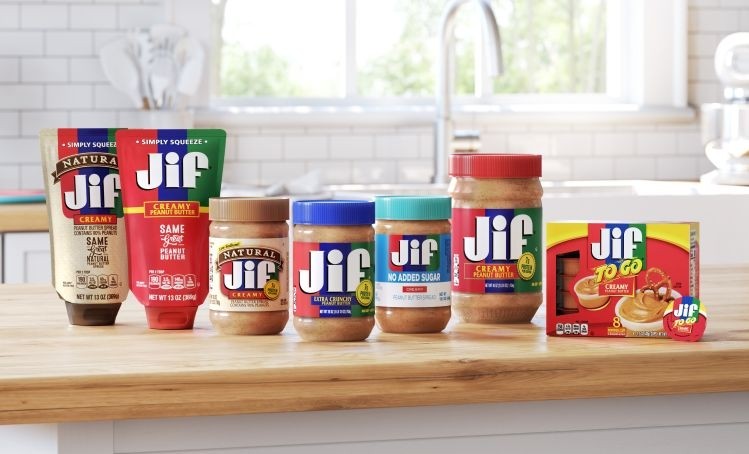Is peanut butter healthy? Not according to new FDA rules, says the Peanut Federation

Published in late September to coincide with the White House Conference on Hunger, Nutrition and Health, the FDA's proposed rule updates the criteria for ‘healthy’ nutrient content claims on food labels, and for the first time restricts the amount of added sugar firms can include in products bearing the claim (see box below).
The deadline for comments is February 16, 2023, with comments thus far largely coming from individuals, with most trade associations and large food companies taking more time to formulate a formal response. However, some industry stakeholders have started to weigh in.
Karl Zimmer, chairman of the United States Peanut Federation, noted that many peanut butters (including market leaders Jif and Skippy) “have a small amount of added sugar for palatability” and as such may not meet the criteria set by the FDA (although the agency has said it may “adjust the baseline values for added sugars as warranted, based on specific considerations of the different food groups and subgroups").
Zimmer added: “Peanut butter is a good source of protein and healthy fats and contains high levels of arginine, an amino acid that can aid in proper growth and development. Under the current proposed rule, peanut butter falls in the ‘Individual Foods: Protein Food Products’ category and would be excluded from the ‘healthy’ definition due to the addition of a small amount of sugar in conventional peanut butter products.
“We propose that the added sugar limit for peanut butter be consistent with the limits placed on dairy products, such as yogurt, which is less than 5% of the RACC in the current proposed rule.”
‘Inconsistences’ in the proposed rule
Additionally, when it comes to saturated fats, he said, ‘While we appreciate FDA’s decision to exclude nuts from the baseline limit for saturated fat, the saturated fat limit for added oils, which stabilize a peanut butter product, should be consistent with the proposed limit for other protein foods (10% DV).”
He also highlighted inconsistencies in the rule around ‘mixed’ products, which he argued were confusing: “According to the current rule, foods that contain dairy have a limit of 7.5% DV for added sugars, while other mixed products have a limit of 2.5% DV.
“The saturated fat limit is similarly inconsistent, with dairy and certain protein-containing foods limited to up to 10% DV while other products have a limit of 5% DV.”
CMI: ‘Dried tart cherries should not be vilified or disadvantaged compared to competitor products’
US growers of tart cherries, which typically require the addition of some sugar for palatability, have also written to the FDA expressing concerns about the proposed rule, which the Cherry Marketing Institute (CMI) says “discourages consumption of nutrient-rich dried tart cherry products, and disadvantages tart fruits in the marketplace as compared to other dried fruits.”
As the proposal defines ‘healthy’ dried fruits as containing zero added sugars, dried Montmorency tart cherries would be unfairly disadvantaged compared to products with the same or comparable total sugar levels such as raisins, “even where their health credentials may be greater, and in some cases even contain less total sugar than comparable products which would meet ‘healthy’ eligibility requirements,” said the CMI.
CMI urges FDA to look again at which dried fruits are eligible to bear the healthy claim
“CMI respectfully requests that the FDA revisit its standards on which dried fruits are eligible to bear the healthy claim… In the proposal, the FDA states that it does ‘not want…to encourage addition of added sugars in otherwise nutrient-dense fruit products, which are generally already naturally sweet.’ That reasoning does not apply to US grown Montmorency tart cherries.”
OGO Foods: ‘Sugar has been unduly vilified’
Snacks supplier OGO Foods, meanwhile, noted that its oat-based snacks comply with the USDA's Smart Snack guidelines, and that the “fiber contained in our whole grain ingredient tends to reduce any glycemic index impact. Also, as a snack, some immediate glucose boost is likely desirable… It is our belief that sugar has been unduly vilified.”
IDFA: Rule would prohibit a 'number of nutrient dense dairy products' from bearing healthy claims
The International Dairy Foods Association has yet to submit a formal comment to the FDA, but immediately raised concerns about several aspects of the proposed rule when it was first released, notably around the limit of 5% DV of added sugar per RACC (reference amount customarily consumed) for dairy (2.5g added sugar) that would prohibit a “number of nutrient dense dairy products” such as yogurts from bearing a healthy claim.
“Moderate levels of added sugars in dairy products increase palatability, thereby encouraging Americans to consume these nutrient-dense foods. IDFA encourages the FDA to revisit this portion of the rule to recognize the benefits of moderate levels of added sugar to increase consumption of nutrient dense, healthy foods, including dairy.”
The 10% DV per RACC limit on saturated fat for dairy products would also “prohibit many nutritious dairy products from carrying a ‘healthy’ claim,” claimed IDFA, while the low limits for sodium also presented challenges for cheese makers: “IDFA encourages the FDA to revisit this portion of the rule to recognize that cheese is the second highest source of calcium yet contributes less than 4% of the sodium to the diet.”
Physicians Association for Nutrition: Food labeling must factor in planetary as well as human health
Echoing comments from those who believe the Dietary Guidelines for Americans should address planetary as well as human health, the Physicians Association for Nutrition said environmental sustainability should be factored into criteria for 'healthy' claims.
“Numerous high-quality scientific studies and reports show beef and dairy to be the most damaging to the environment, and these foods need to be reduced in our diets to improve planetary health. Single-use plastics, including bottled water, should also be phased out.
“Thus, our planet would have negative consequences if these products are labeled ‘healthy’ as they do not support sustainable food production. Finally, unintended consequences, such as lowering fluoride and other beneficial mineral exposures from tap water, also may occur when bottled water is labeled ‘healthy’ based on nutrient content alone.”
Dr Rachel Cheatham: ‘There is a lack of definitive guidance when it comes to fortification as well as use of non-nutritive sweeteners’
Dr Rachel Cheatham, founder of food and nutrition consultancy FoodScape Group, told FoodNavigator-USA that more guidance would be helpful on fortification as well as the use of non-nutritive sweeteners.
“The proposed rule is making a clear statement about emphasizing dietary patterns over individual nutrients by using a food group-based equivalents approach," she told us. "Plus, there are clear limits based on Daily Values for saturated fat, added sugars and sodium. This all nicely aligns with the Dietary Guidelines for Americans.
“However, there is a lack of definitive guidance when it comes to fortification as well as use of non-nutritive sweeteners. Beyond guidance on fortified soy beverages and yogurts, the FDA is ‘concerned that including criteria for nutrients to encourage could spur fortification’ and ‘does not generally support fortification as a method to qualify’ for a claim, but stops short of specifics.
“For non-nutritive sweeteners, the proposed rule states they are ‘not a factor’ and cites the Dietary Guidelines which question their effectiveness. Both fronts need more clear guidance if ‘healthy; claims are to make sense.
What is 'healthy?'
The FDA’s proposed rule (unveiled in September) updates the criteria for the ‘healthy’ nutrient content claim on food labels and for the first time restricts the amount of added sugar firms can include in products bearing the claim.
Rather than requiring minimum amounts of nutrients to encourage, which critics say has tended to encourage fortified junk food rather than a switch to a healthier dietary pattern, the proposed rule reflects “current nutrition science and the Dietary Guidelines” by requiring foods to contain a certain amount of food (a ‘food group equivalent’) from at least one of a list of recommended food groups (e.g., ½ cup of fruit or ¾ cup of dairy) to be labeled ‘healthy.’
According to the agency, “FDA is concerned that including criteria for nutrients to encourage could spur fortification to allow foods that are low in saturated fat, sodium, and added sugars to qualify for the ‘healthy’ claim, despite these foods not contributing to a meaningful amount of a food group (e.g., white bread fortified with calcium).
"We tentatively conclude that using food groups* to encourage as the criteria for 'healthy' rather than a limited set of nutrients, would better identify foods with the nutrient content that may help consumers maintain healthy dietary practices, consistent with current nutrition science and federal dietary guidance."
Limits on sodium, saturated fat, added sugars
It also proposes limits on sodium and saturated fat (which are already included in the current criteria), along with adding a limit on added sugars (which is new).
For sodium, the proposal lowers the criteria from 480mg per 'Reference Amounts Customarily Consumed' (RACC) to <230 mg per RACC for individual foods to be labeled ‘healthy.’
For saturated fat, the FDA is proposing a baseline limit of 5% of the daily value per RACC (≤ 1 g) for most foods, but 10% DV for dairy products, game meats, seafood, and eggs; and 20% of total fat for oils and oil-based spreads and dressings (which would exclude high saturated fat oils such as coconut oil from making healthy claims). It is also “considering an approach using a ratio of saturated fat to total fat.” The limit for total fat has been removed.
For added sugars - which have a daily value of 50g – the FDA is proposing a pretty low baseline value of under 5% of the daily value per RACC (ie. under 2.5g), and for some products, zero grams of added sugar, but says it is “also proposing to adjust the baseline values for added sugars as warranted, based on specific considerations of the different food groups and subgroups.”
Exceptions: Water, whole fruits, veggies
Selected foods that may not meet the above criteria, such as bottled water, eggs, nuts and seeds, whole fruits and vegetables, will also be permitted to make ‘healthy’ claims.
It is also seeking comment on the “eligibility of calorie-free beverages, coffee, and tea to bear the ‘healthy’ claim.”
Healthy symbol
As it revises its definition, the FDA is also researching the effectiveness of a symbol that manufacturers could use on the front of the pack to show that their product meets the definition of the 'healthy' claim.
Having a standardized graphic to show that a food qualifies for the 'healthy' claim would further support the FDA’s goal of helping consumers more easily identify packaged food products that help them build healthy eating patterns, said the agency.








